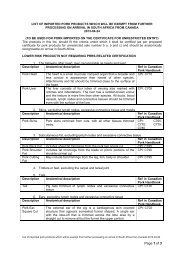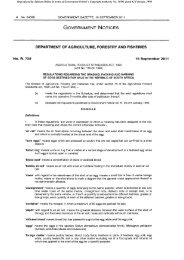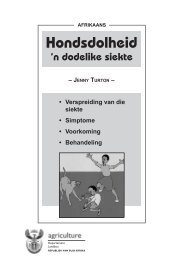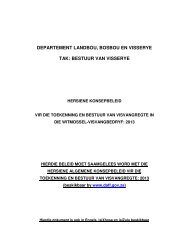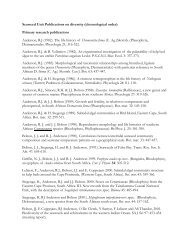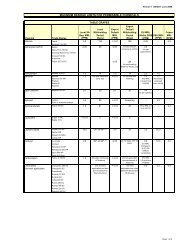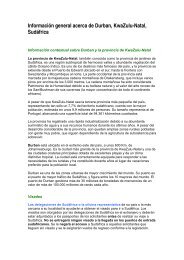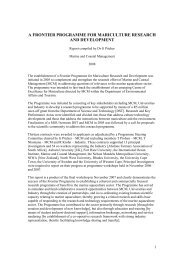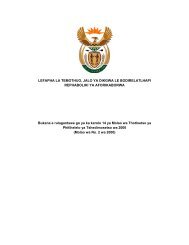You also want an ePaper? Increase the reach of your titles
YUMPU automatically turns print PDFs into web optimized ePapers that Google loves.
M<br />
Feeding<br />
ussels, clams and oysters are all molluscs<br />
belonging to the class Bivalvia, which is so<br />
named because these creatures are protected and<br />
totally enclosed by a pair of shells, one on either<br />
side of the body. Bivalves are relatively sedentary.<br />
Mussels are permanently attachment to rocks by<br />
beard-like byssus threads, and oysters cement one<br />
of their shell valves to the rock face. Many, like the<br />
clams and white mussels, live in sand and have a<br />
l a rge wedge-shaped foot that allows them to burro w.<br />
All bivalves have a reduced head that lacks eyes and<br />
sensory tentacles. Many bivalves are harvested for<br />
food and bait and there are strict regulations<br />
controlling the numbers that can be collected.<br />
Nearly all bivalves have a pair of large gills used for respiration<br />
and filter-feeding. They use hairs on the gills to pump water into<br />
the mantle cavity through an inhalant siphon. The gills trap tiny<br />
particles from the water and move them to the mouth where<br />
the edible particles are eaten, while inedible materials such as<br />
sand grains are discarded along with the waste water that<br />
passes out of an exhalent siphon at the back of the body. A<br />
bed of mussels can remove all the food from the water above<br />
them within an hour. Bivalves are the only molluscs to lack a<br />
radula. Instead they have a thin rod in the gut that is rotated<br />
to grind away the tip, releasing enzymes that digest the food.<br />
Brown mussel is attached to rocks on<br />
the south and east coasts<br />
muscle<br />
cut open<br />
mussel<br />
gonads<br />
gill<br />
C O A S TA L A N D M A R I N E L I F E – A N I M A L S : I N V E RT E B R A T E S – M O L L U S C S<br />
foot<br />
Reproduction and life cycle<br />
Most bivalves practise external fertilisation and shed enormous<br />
numbers of sperm and eggs into the sea where they develop<br />
into planktonic larvae. The early trochophore larvae are like<br />
miniature spinning tops. They metamorphose into veliger<br />
larvae each with a tiny shell and two large anterior lobes, the<br />
velum, that propel the animal along by flickering hair-like cilia.<br />
The larvae are attracted to, and settle at, sites where adults<br />
occur and are then known as spat. A few species brood their<br />
eggs inside their shells.<br />
Pollution and red tide<br />
The major drawback of the efficient filtering system of bivalves<br />
is that they collect and concentrate pollutants and toxic<br />
organisms such as those associated with 'red tide'. Mussels<br />
retain the poisons from a red tide in their bodies for about 4<br />
months. Although the mussels are not usually harmed, as few<br />
as two mussels contaminated with toxic red tide can prove fatal<br />
if eaten by humans. The Marine and Coastal Management<br />
branch of the Department of Environmental Affairs and To u r i s m<br />
can be contacted to get the latest information about red<br />
tides, which occur almost exclusively along the west coast.<br />
See the bottom of this factsheet for contact details.<br />
Mariculture<br />
Bivalves<br />
Mussels and oysters are farmed on rafts in the sheltered bays<br />
of Saldanha and Knysna. The Mediterranean or blue mussel<br />
is preferred to the local mussels because it is plumper and<br />
faster growing and is ready for harvest in about 9 months.<br />
Although they are fast growing, mussels do not fetch as high<br />
byssus threads<br />
waste water<br />
expelled<br />
White mussel digs<br />
into the sand<br />
water and food<br />
particles<br />
sucked in<br />
foot<br />
3B





